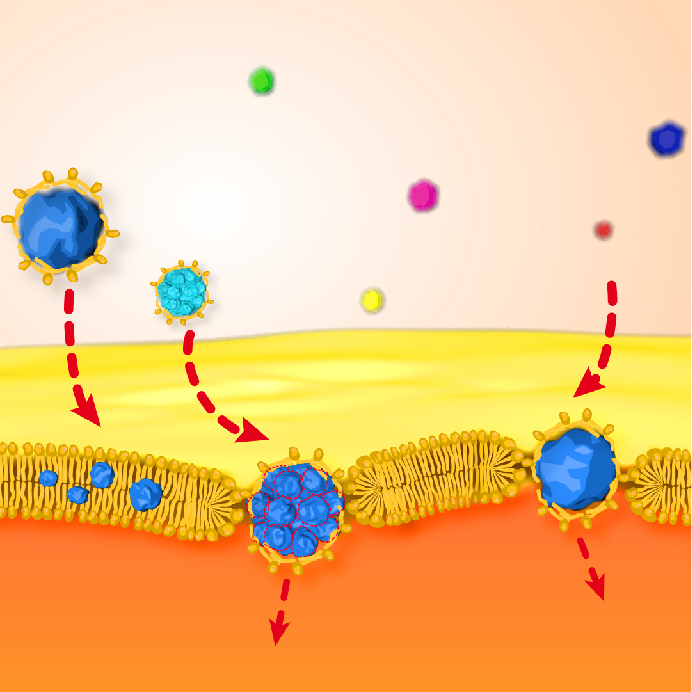28/11/2016
First time physicists observed and quantified tiny nanoparticle crossing lipid membrane
This discovery may raise concerns about safety of nanomaterials for public health and may suggest to revise the security norms at nanoscale bringing attention to the safety of nanomaterials in general

This discovery may raise concerns about safety of nanomaterials for public health and may suggest to revise the security norms at nanoscale bringing attention to the safety of nanomaterials in general
Nanomaterials have invaded most of products used in our daily life. They are found everywhere: from cosmetics (creams, toothpastes, and shampoo), food components (sugar, or salt), clothes, buildings cement, paints, car tires, oil, electronic products (smartphones, screen), energy, pharmaceutics (drugs, medical imaging). The OECD recently reported that nanoparticles are present in more than 1300 commercial products where we ignore the potential toxicity for people, animals and environment. The absence of reliable tools to monitor nanoscale objects and tremendous number of mechanisms of possible toxicity leads to controversial regulations in nanotoxicity: for example, nanoparticles in creams are not crossing the human skin, but may enter through lungs or mucus layer. That is why the exact way how certain nanoparticle interact with human tissues and barriers, including cell membranes is still not well understood. One of the reasons is the enormous difficulty to visualize individual nanoparticles. Indeed, nano-objects are below diffraction limit and thus below the capacities of optical microscopes. As a result, special and original techniques have to be designed to see the events in submicron world. Another difficulty related to tiny particles: they move fast and the processes associated with them last fractions of seconds: the measurement should be also fast.
Based on these concerns, the team of theoretical physics at Universitat Rovira i Virgili in Tarragona, led by Dr. Vladimir Baulin, the coordinator of European Network ITN SNAL, designed a research project to investigate the interaction between nanoparticles and lipid membranes. In computer simulations, the researchers first created what they call a “perfect bilayer”, in which all of the lipid tails stay in place within the membrane. Based on their calculations, the team of Dr. Baulin observed that small hydrophobic nanoparticles can insert into the lipid bilayer if their size is similar to the thickness of the membrane (around 5 nanometers).
They observed that these nanoparticles stay trapped in the cell membrane, as commonly accepted by the scientific community. But a surprise appears when they studied the case of superhydrophobic nanoparticles, as these nanoparticles could not only insert into the cell membrane but they could also escape this membrane spontaneously.
“It is generally accepted that smaller the size of the object, easier to cross the barriers. Here we see opposite scenario: NPs with size >5nm can cross the bilayer spontaneously.” says Dr. Baulin.
This is where Dr. Baulin contacted Dr. Jean-Baptiste Fleury at the Saarland University (Germany) to confirm this mechanism and to study experimentally this unique translocation phenomena. Dr. Fleury and his team, designed a microfluidic experiment to form phospholipid bilayer systems, which can be considered as artificial cell membranes. With this experimental setup, they explored the interaction of individual nanoparticles with such an artificial membrane. The used gold nanoparticles had an adsorbed lipid monolayer that guarantees their stable dispersion and prevent their clustering. Using a combination of optical fluorescent microscopy and electrophysiological measurements, the team of Dr. Fleury could follow individual particles crossing a bilayer and unravel their pathway on a molecular level. And as predicted by the simulations, they observed that nanoparticles insert into the bilayer by dissolving their lipid coating into the artificial membrane. Nanoparticles with a diameter equal or larger than 6 nm, i.e. the typical extension of a bilayer, are able to escape the bilayer again with very few milliseconds, while smaller nanoparticles remain trapped in the core of the bilayer.
This discovery of fast translocation of tiny gold nanoparticles through barriers protecting cells, i.e. lipid bilayer, may raise concerns about safety of nanomaterials for public health and may suggest to revise the security norms at nanoscale bringing attention to the safety of nanomaterials in general.
Reference: Yachong Guo, Emmanuel Terazzi, Ralf Seemann, Jean Baptiste Fleury, Vladimir A. Baulin, “Direct proof of spontaneous translocation of lipid-covered hydrophobic nanoparticles through a phospholipid bilayer”. Science Advances DOI: 10.1126/sciadv.1600261
